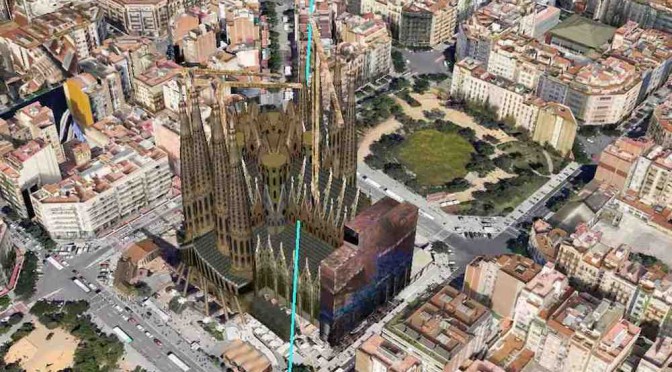Navigational system
From the earlier work I came to the conclusion that there was a high probability of a viable navigation system covering the whole of this area and quite possibly a much wider area. The system could then have been used to produce maps using the myriad of points created by the pentacles themselves and the alignment lines running in every direction. To create maps, however, the measurements of the pentacles would have to be known.
Fibonacci Proportions
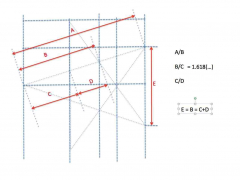 Thus using 1,2,3,5,8 etc as dimensions of the various components of a pentacle will not work, it will not be possible to predict the size of other components.
Thus using 1,2,3,5,8 etc as dimensions of the various components of a pentacle will not work, it will not be possible to predict the size of other components.
What is always true is that the dimensions are still related to the golden number. Thus in this diagram A/B is always 1.618(….)even though the individual lengths may not be Fibonacci numbers.
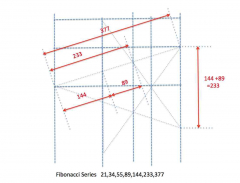 This diagram shows Fibonacci numbers which are sufficiently high in the series to make this possible.
This diagram shows Fibonacci numbers which are sufficiently high in the series to make this possible.Using the numbers 34,55,89,144,233,etc will make it possible to predict the size of other components.
All the main dimensions will be numbers from the Fibonacci Sequence.
Trigonometry
 it would then be possible to predict the distance between North-South alignment lines (and every other set of alignment lines)
it would then be possible to predict the distance between North-South alignment lines (and every other set of alignment lines)
 By the successive use of the properties of triangles more and more information about distances between the alignments be obtained . Here the distance between two points of a pentacle ,and therefore the side of the enclosing pentagram can be calculated. now howe.ver we are using the other side of the use of pentacles , that the size of angles is known and repeatable
By the successive use of the properties of triangles more and more information about distances between the alignments be obtained . Here the distance between two points of a pentacle ,and therefore the side of the enclosing pentagram can be calculated. now howe.ver we are using the other side of the use of pentacles , that the size of angles is known and repeatable
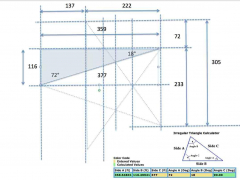 Here distances between N-S alignment lines and E-W alignment lines are being calculated.
Here distances between N-S alignment lines and E-W alignment lines are being calculated.
 It would have been within the capability of many of those carrying out surveying work to carry out these calculations.
It would have been within the capability of many of those carrying out surveying work to carry out these calculations.
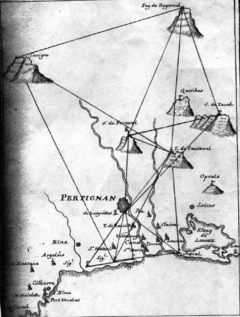 However unlike triangulation, surveyors in the field would not have to work out these dimensions in the way shown here , they could be read from tables. These calculations only had to be performed once as all the pentacles are specifically constructed to be identical. Here for comparison is another look at the preliminary notes made by Cassini, showing the enormous variation in the measurements and triangles he was using.
However unlike triangulation, surveyors in the field would not have to work out these dimensions in the way shown here , they could be read from tables. These calculations only had to be performed once as all the pentacles are specifically constructed to be identical. Here for comparison is another look at the preliminary notes made by Cassini, showing the enormous variation in the measurements and triangles he was using.
Lacework
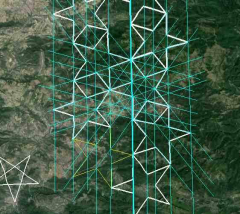 And then another look at the criss crossing lines of the pentacles themselves and the alignment lines, an absolute lacework available in which every dimension is known. extremely useful in the production of maps but giving no clear clues as to the location of the Treasure. Perhaps putting a X on a map did not give adequate protection. The location would have to be hidden in some cryptic clue but could that be based on a knowledge of the navigation system?
And then another look at the criss crossing lines of the pentacles themselves and the alignment lines, an absolute lacework available in which every dimension is known. extremely useful in the production of maps but giving no clear clues as to the location of the Treasure. Perhaps putting a X on a map did not give adequate protection. The location would have to be hidden in some cryptic clue but could that be based on a knowledge of the navigation system?Wouldn’t it be wonderful if there was a unit of measurement which gave a match for these higher fibonacci numbers and could be used to construct pentacles “on the ground”
Centimilles
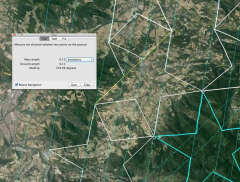 Armed with the knowledge that there is a “golden number” relationship between kilometres and royal french miles, the measurement tool in google earth was switched from Miles to Kilometers. I had been previously been measuring distances in miles because several writers had talked in favour of the real measurements having been made in chains, rods or perches which are all subdivisions of a mile.
Armed with the knowledge that there is a “golden number” relationship between kilometres and royal french miles, the measurement tool in google earth was switched from Miles to Kilometers. I had been previously been measuring distances in miles because several writers had talked in favour of the real measurements having been made in chains, rods or perches which are all subdivisions of a mile.
Now I concentrated on Kilometres and took the very first measurement across the side of a pentacle. It is displayed as a yellow measurement lineof value 6.11 Kilometers * 0.6172 =3.77 miles =377 Centi-milles. 377 is a Fibonacci number and sufficiently large for the golden number relationships to apply.
Why is the Conversion number not a perfect golden number? it is all to do with the use of decimal places. I believe it is the 6.11 measurement which is slightly wrong not the centi-milles.
Predictablity
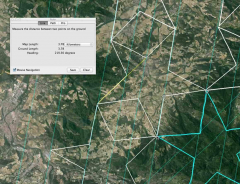 It should come as no surprise that this second measurement also converts to a member of the fibonacci series.
It should come as no surprise that this second measurement also converts to a member of the fibonacci series.
The numbers are high enough in the series for the relationship to be valid. 3.78 Kilomenters * 0.6172 = 233 centi-miles
 And so it continues. A centi-milles is one hundredth of a French Royal mille. I can find no confirmation for it’s existence but it seems a reasonable assumption that it would have been used was used.
And so it continues. A centi-milles is one hundredth of a French Royal mille. I can find no confirmation for it’s existence but it seems a reasonable assumption that it would have been used was used.
Conversions
 2.33 Kilometers converts to another Fibonacci number(144) In fact every measurement converts to a Fibonacci number.
2.33 Kilometers converts to another Fibonacci number(144) In fact every measurement converts to a Fibonacci number.
In this case 1.44 converts to 89 Centi-Milles.
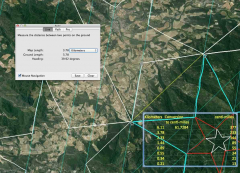 The side of the enclosing pentagram is also a Fibonacci number. Now another relationship is revealed.
The side of the enclosing pentagram is also a Fibonacci number. Now another relationship is revealed.
If the metric distances had been measured in Centi-Kilometers (a unit of 10 meters) then the metric measurements would also be Fibonnaci numbers but always on higher in the series that the cent-mille equivalent!
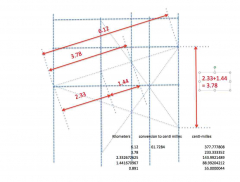 These metric numbers therefore give rise to the Fibonacci relationship which applies to every pentacle including the Rennes pentacle.
These metric numbers therefore give rise to the Fibonacci relationship which applies to every pentacle including the Rennes pentacle.
All the distances in alignments, calculated at the bottom of the navigation construction page, apply to all the alignment lines running in every direct without any further conversion.
Nesting Pentacles
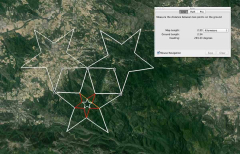 The Fibbonaci numbers also dictate the dimensions of the smaller pentacles.
The Fibbonaci numbers also dictate the dimensions of the smaller pentacles.
In this case 2.33 kilometres is the side of the middle sized pentacle, is the same as the side of one of the points of the larger pentacle of value 144.
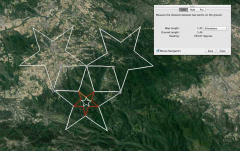 Obviously once once key dimension of the middle sized pentagon is found to be a Fibonacci number all the other key dimensions will also be Fibonacci numbers.
Obviously once once key dimension of the middle sized pentagon is found to be a Fibonacci number all the other key dimensions will also be Fibonacci numbers.
Every dimension is predictable.
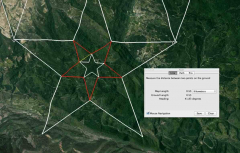 This dimension is the side of the pentagon enclosing the smallest pentacle.
This dimension is the side of the pentagon enclosing the smallest pentacle.
Therefore key dimensions of the smallest pentacle should also be Fibonacci numbers or should they?
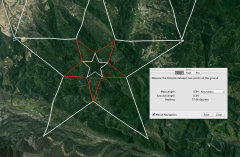 Certainly the side of the point seems to comply
Certainly the side of the point seems to complySystem Breakdown
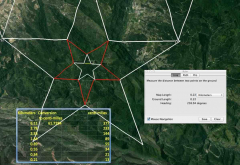 But here finally the relationship breaks down. As can be seen from the table to generate the fibonacci number 13 as a centi-mille measurement. The dimension should be 0.21 Kilomenters but in fact it is 0.22. this is because we have now come to low in the series for the golden relationship to be valid.
But here finally the relationship breaks down. As can be seen from the table to generate the fibonacci number 13 as a centi-mille measurement. The dimension should be 0.21 Kilomenters but in fact it is 0.22. this is because we have now come to low in the series for the golden relationship to be valid.
Conclusion
I find all this interesting and surprising. It means that it is possible that there was a viable navigation system which could be used to draw maps on which the location of the treasure could be marked. Alternatively the system of pentacles itself could be used to locate the hiding place. This second method could be codified and without a knowledge of how the navigation system works be difficult to penetrate. But does any of this give us a clear idea of where the treasure is or might be? No! emphatically not!
